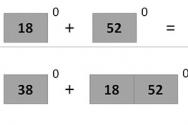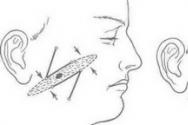Closing the month: postings and examples. Closing the month: postings and examples Accounting for depreciation
Closing account 02 “Depreciation of fixed assets”
DEBIT 01 subaccount “Disposal of fixed assets” CREDIT 01
— the initial cost of the disposed object is written off;
DEBIT 02 CREDIT 01 subaccount “Disposal of fixed assets”
— the amount of depreciation accrued on the disposed object is written off;
DEBIT 91 subaccount “Other expenses” CREDIT 01 subaccount “Disposal of fixed assets”
— the residual value of the disposed object is written off (the original cost of the object minus accrued depreciation).
Thus, the residual value of the disposed object is formed on account 01. In this case, it will be equal to zero if the object is completely depreciated. That is, in such a situation, the initial cost of the fixed asset is equal to the amount of accumulated depreciation and there is no balance on account 01.
A similar entry is made when writing off depreciation for missing or completely damaged fixed assets. It is not possible to close account 02 for other reasons.
Please note: when closing account 02, account 01 will appear for transactions with fixed assets that are used directly in the activities of your company. If we are talking about property that was rented out exclusively, then account 03 “Profitable investments in material assets” will be used. After all, it is in this account that, according to the Instructions to the Chart of Accounts, such assets are supposed to be accounted for.
If depreciation is accrued excessively, then if an error is detected in the current year, the excessively accrued amount is reversed (see accrual entries Here).
Account 86 is used by enterprises and organizations that receive targeted funds from government and commercial sources. We will look at how target financing is accounted for, the receipt and use of funds, in our article.
Account 86: use
Account 86 takes into account the amounts of funds received by the organization to finance targeted activities. The sources of funds can be both state-owned companies and commercial firms and even private individuals.
The main criterion for accounting for funds in account 86 is a clear definition of the purpose and purpose of their use in accordance with the concluded agreement.
Account 86, as a rule, takes into account funds received by the organization for the purpose of financing social programs and socially beneficial events (subsidies for utility bills, subventions for the construction of social housing, support for preferential and low-income categories of the population, etc.).
Accruals of target funds are reflected according to Kt 86. Dt 86 is used to account for the use of funds received within the framework of contractual terms.
Let's look at typical wiring:
Video lesson “Accounting for target financing”: postings, examples
Video lesson about accounting in an organization using account 86 “Targeted financing”. Practical examples with accounting entries are analyzed. The lesson is taught by the teacher of the “Accounting and Tax Accounting” website, chief accountant Gandeva N.V. ⇓
Accounting account 86: typical entries in infographics
The figure below shows accounting account 86 “Targeted financing” in the infographic. To enlarge the picture, click on it.

Account 86 “target financing”. Postings
Accounting for receipt and write-off of target funds using examples
For a detailed examination of various operations using target revenues, we use illustrative examples of typical situations.
Receiving government subsidies
JSC “Minister” operates in the field of real estate construction. In March 2016, “Minister” took part in a tender to receive government subsidies for their subsequent use for the construction of social housing. The amount of state aid is 3,478,000 rubles.
In April 2016, upon completion of the tender, JSC “Minister” was recognized as the winner, and therefore funds in the amount of 3,478,000 rubles were credited to the organization’s current account. In addition, the Minister received construction materials in the form of state aid, the cost of which amounted to 1,714,200 rubles.
The received government subventions were taken into account by the “Minister” in the following way:
| Debit | Credit | Operation description | Sum | A document base |
| 86 | The amount of funds accrued as government subventions is reflected (RUB 3,478,000 + RUB 1,714,200) | 5,192,200 rub. | Targeted financing agreement | |
| 51 | 76 Targeted financing funds | The funds received by the “Minister” as a state target program are taken into account | 3,478,000 rub. | Bank statement |
| 10 | 76 Targeted financing funds | Materials received by the “Minister” for use in the construction of social housing were taken into account | 1,714,200 rub.) | Bank statement |
Reimbursement by the state for lost income
As part of the state program, JSC “Canteen No. 1” provides social food distributions to preferential categories of the population. The cost of rations issued to Canteen No. 1 in November 2015 is 412,850 rubles. This amount is fully compensated from the state budget.
The accountant of Canteen No. 1 made the following entries in the accounting records:
Investment of targeted proceeds in non-current assets
Progress JSC is engaged in the production of medical equipment. An agreement was concluded between JSC Progress and the charitable organization Mecenat, according to which:
- “Progress” receives funds from “Maecenas” in the amount of 1,953,500 rubles;
- the funds should be used to purchase an improved conveyor line, which will increase the production of medical equipment.
In September 2015, funds were received from Maecenas, the conveyor line was purchased and put into operation:
- cost of the conveyor line - 1,953,500 rubles;
- useful life – 12 years;
- the amount of monthly depreciation is 12,522 rubles. (RUB 1,953,500 / 13 years / 12 months).
The receipt of funds from “Maecenas”, the acquisition and commissioning of the conveyor line were recorded in the accounting records of “Progress” with the following entries:
| Debit | Credit | Operation description | Sum | A document base |
| 76 Targeted financing funds | 86 | The amount of accrued funds is reflected as received under an agreement with BO “Mecenat” | 1,953,500 rub. | Agreement |
| 51 | 76 Targeted financing funds | Targeted funds received from the charity “Mecenat” are taken into account | 1,953,500 rub. | Bank statement |
| 08 | 60 | The receipt of the purchased conveyor is reflected | 1,953,500 rub. | Packing list |
| 01 | 08 | The operation to put the conveyor into operation was carried out | 1,953,500 rub. | OS commissioning certificate |
| 86 | 98 | The intended use of funds received from the charitable organization “Mecenat” is reflected | 1,953,500 rub. | Agreement, Consignment note, OS commissioning certificate |
| 20 | 02 | The amount of monthly accrued depreciation on the conveyor is taken into account | RUB 12,522 | Depreciation statement |
| 98 | 91.1 | Other income is taken into account from the amount of deferred income (in the amount of accrued depreciation) | RUB 12,522 | Depreciation statement |
Use of targeted funds for current needs
JSC “Consul”, under a targeted financing agreement, transferred funds to LLC “Zoo” in the amount of 642,300 rubles. Funds have been provided for the repair of animal enclosures. Using the funds received from the Consul, the Zoo purchased the materials necessary to repair the enclosures. The actual repairs were carried out by the Zoo’s own staff.
The following transactions are recorded in the Zoo’s accounting records:
| Debit | Credit | Operation description | Sum | A document base |
| 76 Targeted financing funds | 86 | Reflects the amount of accrued funds on account of receipt under the agreement with JSC “Consul” | 642,300 rub. | Agreement |
| 51 | 76 Targeted financing funds | Targeted funds received from JSC “Consul” are taken into account | 642,300 rub. | Bank statement |
| 10 | 60 | The Zoo warehouse received materials purchased for the repair of animal enclosures | 642,300 rub. | Packing list |
| 86 | 98 | Materials purchased for repairs are accounted for as deferred income | 642,300 rub. | Packing list |
| 20 | 10 | The fact of using materials in the repair of animal enclosures is reflected | 642,300 rub. | Packing list |
| 98 | 91.1 | Other income from the amount of deferred income is taken into account | 642,300 rub. | Agreement, Consignment note |
At the beginning of the next month, the ending balance will be the beginning balance for each subaccount. Postings: November: the ending balance from October for each subaccount will be the beginning balance, in the figure it is indicated in green. During November there was only one shipment of a batch of products with a cost of 80,000 rubles. at a sales price of 118,000 rubles. in view of VAT. Account 90 looks like this at the end of November: Financial result for the month = 118,000 - 80,000 - 11,800 = 26,200. For each subaccount at the end of November, the turnover for the month is again calculated, to which the opening balance at the beginning of the month is added, after which the balance at the end of November is displayed for each subaccount. December: The ending balance for November will be the opening balance for December (green in the figure below). During the month there were 2 shipments for 23,600 (cost price 15,000) and for 70,800 rubles. (cost price 50,000).
Closing the month: postings and examples
The organization itself chooses the method and consolidates it in its accounting policy. Let's consider both options for closing the cost price for the data of Lyutik LLC. Postings for closing expense accounts at the end of the month when using the write-off of costs for direct expenses: Dr Cr Description of transaction Amount, rub.
Document 20 26 Closing for production costs 250,000 Accounting certificate 90.2 20 Closing the account for cost (250,000+96,000+780,000+17,000) 1,143,000 Accounting certificate Postings when writing off costs using the direct costing method: Dt Ct Description of the transaction Amount, rub. Document 90.8 26 Write-off of general business expenses 250,000 Accounting.
certificate 90.2 20
Write-off of production costs (96,000+ 780,000+17,000) 893,000 Accounting. certificate Closing account 90 posting: Dt Cr Description of transaction Amount, rub. Document 90.9 90.2 Expenses written off (1,143,000+893,000+400,000+162,000) 2,598,000 Accounting.
Analysis of account 90: sale of finished products, goods
Info
How to properly record depreciation? And if option 2 is correct, then what kind of wiring should there be? 🙁 Thanks in advance everyone! marakuia 06/23/2011, 16:33:21 Accounts 01 and 02 are closed among themselves only upon disposal of the fixed assets. The balance sheet reflects the difference between them at the beginning and end of the reporting period.
The balance on both accounts will always hang, even if the operating system is completely depreciated. Then the balance sheet will be “zero”. Depreciation – D.20, 26, 44, etc.
By 02. Mariellee 06/23/2011, 16:58:41 Now, at the end of the month, depreciation is calculated D26-K02.1. 01 account remains the same initial amount which is simply transferred every year to the debit balance. (I'm talking about SALT) 02 account I have a balance on the Loan, in the current period another credit (accrued depreciation) amount is added to it and at the end there is again a credit balance but this time more by the amount accrued for the period.
Posting of accounting accounts. closing accounts (postings)
We continue to take into account all sales transactions throughout the month, and at the end of the month we again calculate the financial result for the month. And this continues from month to month until the end of the year. Closing account 90 at the end of the year (postings): At the end of the year, account 90 must be closed so that the balance of each subaccount becomes zero.
In this case, each subaccount is closed to subaccount 90/9:
- 90/1: we consider the final balance, it is a credit balance, in order for the balance on this subaccount to become zero, you need to post D90/1 K90/9.
- 90/2: we calculate the final balance, it is a debit, in order for the balance to become equal to zero, we carry out the posting D90/9 K90/2.
- 90/3: similar to subaccount 2, we carry out posting D90/9 K90/3.
- 90/9: now, if you calculate the final balance on this subaccount after completing all previous entries, it will be equal to 0.
Account 90 is closed.
How to close account 91
In accounting, income and expenses can be of several types:
- for ordinary activities, which are reflected in account 90 “Sales”;
- others, which are recorded on account 91 “Other income and expenses”.
Accounting for other income and expenses is carried out on account 91 “Other income and expenses”. The following sub-accounts are opened for this account:
- 91-1 “Other income”;
- 91-2 “Other expenses”;
- 91-9 “Balance of other income and expenses.”
After you have closed the sub-accounts to account 90, you need to close all sub-accounts opened to account 91 “Other income and expenses”.
Do it this way: Debit 91-1 Credit 91-9 – subaccount 91-1 is closed at the end of the year; Debit 91-9 Credit 91-2 – subaccount 91-2 is closed at the end of the year. Example In 2012, an organization received income from renting out property in the amount of 159,300 rubles. (including VAT - 24,300 rubles).
Closing the year: accounting entries
If the house is not destroyed in 10 years (and there is a high probability that it will not be destroyed), and it is already completely depreciated, but will continue to be rented out and generate income, then what should I do? How to restore the cost? 😮 Larky 24-06-2011, 13:21:54 There is no need to restore the value... The original cost of the object is listed at 01, it does not disappear anywhere...
And on 02 you see what part of the cost of the object has been transferred to the cost of products, works, services... When the amount on 02 becomes equal to the initial cost of the object, this will mean that the entire cost of the object has gone into expenses, depreciation has stopped, the object has been fully paid off and its use already brings net income... :) And this can continue until the object becomes completely unsuitable for further use and is liquidated...
Closing the month is a list of mandatory transactions and entries made to determine the interim financial result. Let's look at the basic transactions for closing a month manually using an example.
- 1 Closing the month in accounting: main stages
- 1.1 Stage 1. Determining monthly costs
- 1.2 Stage 2. Closing accounts at the end of the posting month
- 1.3 Stage 3.
Determination of financial result
- 1.4 Closing accounts 90, 91, 99 transactions at the end of the month
The procedure for closing a month in accounting includes:
- Determining costs and writing them off to cost;
- Closing sales accounts and determining financial results;
- Closing income and expense accounts and determining the tax base.
Depreciation of the company's property assets, distributed evenly over the period of their use, calculated in monetary terms, is called depreciation charges. In this article we will tell you which accounting accounts should be used to reflect depreciation and which entries to record depreciation operations.
Features of depreciation accounting
Accrued depreciation charges (AM) are accumulated in special account 02 in accounting. Depreciation accounting is carried out for each property of the company. It is unacceptable to make accounting entries without detailing the accounting objects.
Taking into account the peculiarities and specifics of its activities, each company has the right to open additional sub-accounts to account 02. Such detailing is carried out by the types of property assets owned by the company. For example, the company uses subaccounts: 02-01 - depreciation for buildings; account 02-02 - depreciation of machinery and equipment; 02-03 - AM on vehicles.
A complete list of subaccounts used should be determined individually for each company and fixed in the accounting policy.
Let us note that the property must be owned, because assets accepted for temporary safekeeping are not accepted on the balance sheet and are subject to accounting off the balance sheet, on the books. account 002. For assets capitalized on off-balance sheet accounts, depreciation is not accrued. However, there are exceptions. For example, objects received for rent or under leasing agreements, which, according to the terms of the agreement, must be taken into account on the balance sheet of the lessee.
Accounting structure and typical postings
As we noted earlier, accounting account 02 is used to maintain accounting records for the amounts of calculated AM in the context of each property and tangible asset.
02 which account: passive or active? Accounting account 02 is passive, since the amounts of accrued depreciation on property objects are reflected as a credit, and the write-off of the calculated AM is reflected as a debit.
Account structure:
- the credit balance at the beginning of the reporting period shows the amount of calculated depreciation at the beginning of the reporting period;
- credit turnover for the period reflects the amount of accrued AM for the selected period of time;
- debit turnover in accounting account 02 indicates the amount of written-off depreciation charges for retired objects (written off, sold, transferred to third parties);
- The credit balance at the end of the reporting period is the amount of accumulated depreciation charges at the end of the reporting period.
Typical wiring:
Closing an account 02
It is necessary to write off accrued AM in different cases, but in this situation one condition applies: the fixed asset must be deregistered from the company's register. In other words, the depreciation accounting account is closed if property is deregistered upon sale, gratuitous transfer, damage, liquidation, and in other situations provided for by PBU.
Therefore, the question of how to close account 02 with full depreciation is not relevant. Depreciation will be recorded in the credit balance of account 02 until the company decides to write off the object. Let us remind you that complete depreciation is the complete attribution of the original cost to the AM.
Typical depreciation write-off entries.
The procedure for generating accounting entries is based on the recognition of certain accounting accounts as active, passive or active-passive. Accordingly, an increase in various accounting objects can be reflected not only exclusively in the debit or credit of any account. In separate accounting accounts, an increase in accounting objects can be reflected in both the debit and credit of the same account, depending on the situation. What account is accounting account 02 “Depreciation of fixed assets” ()?
02 account: active or passive?
The characteristics of account 02 are contained in the Instructions for the use of the Chart of Accounts for accounting the financial and economic activities of organizations (Order of the Ministry of Finance dated October 31, 2000 No. 94n).
This account summarizes information about depreciation accumulated during the operation of fixed assets.
Accrued depreciation is reflected on the credit of account 02 in correspondence, as a rule, with the accounts of production costs or sales expenses:
Debit accounts 20 “Main production”, 26 “General business expenses”, 44 “Sales expenses”, etc. – Account credit 02
But, of course, these are not the only accounts that are debited. In posting D 91 - K 02, the accounting account shows that depreciation is taken into account as part of other expenses. Such an entry may occur, for example, if depreciation of equipment leased is accrued (when such rental is not systematic) (clause 11 of PBU 10/99).
Considering that depreciation of fixed assets is accumulated on the credit of account 02, this accounting account is passive. But it is important that it is not reflected in the liabilities side of the balance sheet. After all, the balance is formed in a net assessment (clause 35 of PBU 4/99). In relation to fixed assets, this means they are reflected in the balance sheet at their residual value. In other words, the accounting value (recorded as the debit of account 01) is reduced by the credit balance of account 02 as of the reporting date.
As for analytical accounting on account 02, it is maintained for individual inventory items of fixed assets.
How to close account 02 “Depreciation of fixed assets”?
Considering that account 02 is passive, the amount of accrued depreciation is reduced (written off) by debiting this account. How to close 02 account? When disposing of fixed assets (sale, write-off, gratuitous transfer, etc.), the amount of depreciation accumulated at the time of disposal is written off as follows (Order of the Ministry of Finance dated October 31, 2000 No. 94n):
Debit account 02 – Credit account 01 “Fixed assets”
As a result of this kind of operation, for example, the balance sheet for account 02 will reflect not only credit, but also debit turnover.
When talking about synthetic account 02, it is important not to confuse it with subaccount 02 to other accounts. For example, account 68.02 in accounting has nothing to do with depreciation. After all, account 68 is “Calculations for taxes and fees,” and 02 in this case is a subaccount to account 68, indicating the type of tax. As a rule, account 68.02 reflects information on settlements with the budget for VAT.








